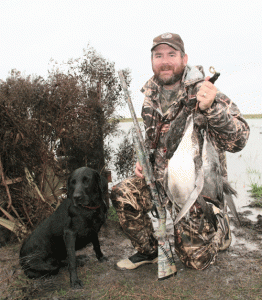The mid-November blast of cold weather sent big time numbers of ducks and geese down the Central Flyway, and so far numbers of ducks on the middle Texas coast are definitely better than expected.
I recently hunted with guide Will Granberry who runs duck and goose hunts near Wharton and Port Lavaca. Three of us ended up with 18 ducks and a specklebelly goose. On that particular morning we had a mild cold front moving through and it never quit raining. But the numbers of birds we saw were very impressive. We had several groups of pintails, teal and gadwall come in over the decoys. Just before we picked up the spread we had a flight of 25 or so snows come in low but flared right at the last moment. The numbers of specks moving around was better than expected.
“So far this season we’re racking up good numbers of ducks over flooded fields,” says Granberry. “ I think our next push of cold weather will move lots of ducks and geese our way.”
Granberry runs hunts on flooded fields and on the bays out of Matagorda and Port O’Connor for ducks, geese and sand hill cranes. For more info check out his web site at www.avianskies.com. His cell number is 361-235-0100.
Big bucks are running does
Deer hunters are seeing lots of bucks chasing does in East Texas and the Hill Country. This is a good time to tag a few does while they are still in good shape.
I talked with a couple of buddies who recently added a new twist to their deer hunts – night vision scopes. Cody Bell and Ron Jaap recently went night hunting for pigs after day time deer hunts. Two nights going they eased up on baited cattle tanks and shot at pigs both times.
“A night vision scope is definitely expensive but it adds a whole new type of adventure to our pig hunting,” says Jaap. “You can hunt deer all day, and pigs all night. The only problem is finding enough time to sleep.”
Cedar Bayou study releases tagged reds
Cedar Bayou and Vinson Slough were opened on September 25, after having been sealed in the 1970s and enduring decades of negative impacts from siltation and low water flows. Local media were invited to view the ribbon-cutting ceremony and opening last Thursday.
Cedar Bayou is a natural pass that separates San Jose Island from Matagorda Island. Dredging efforts date back to the 1930s, but partial efforts, siltation, and misplacement of spoil materials eventually led to the pass and adjacent Vinson Slough being sealed. The restoration of Cedar Bayou and Vinson Slough has created the vital connection from Mesquite and Aransas Bays to the Gulf of Mexico.
The Center for Sportfish Science and Conservation has surgically implanted several redfish with tracking technology as part of the Cedar Bayou study. Each of these fish is marked with a green external dart tag. Definitely release these fish if caught and call the phone number on the tag to let researchers know where you caught the fish and to add valuable movement information to their study. If you decide to keep a tagged fish or if the fish dies in the process of being caught, keep the black cylindrical acoustic tag implanted in the fish and call (361) 825-2028. This research is heavily dependent on the cooperation of local anglers.
Capt. Robert Sloan runs bay, jetty and duck hunting trips out of Port O’Connor. For details call 409-782-6796.

Waterfowl guide Will Granberry and his retriever RayRay recently put a group of hunters on 18 ducks and a goose while hunting on a flooded field near Port Lavaca. Robert Sloan photo
